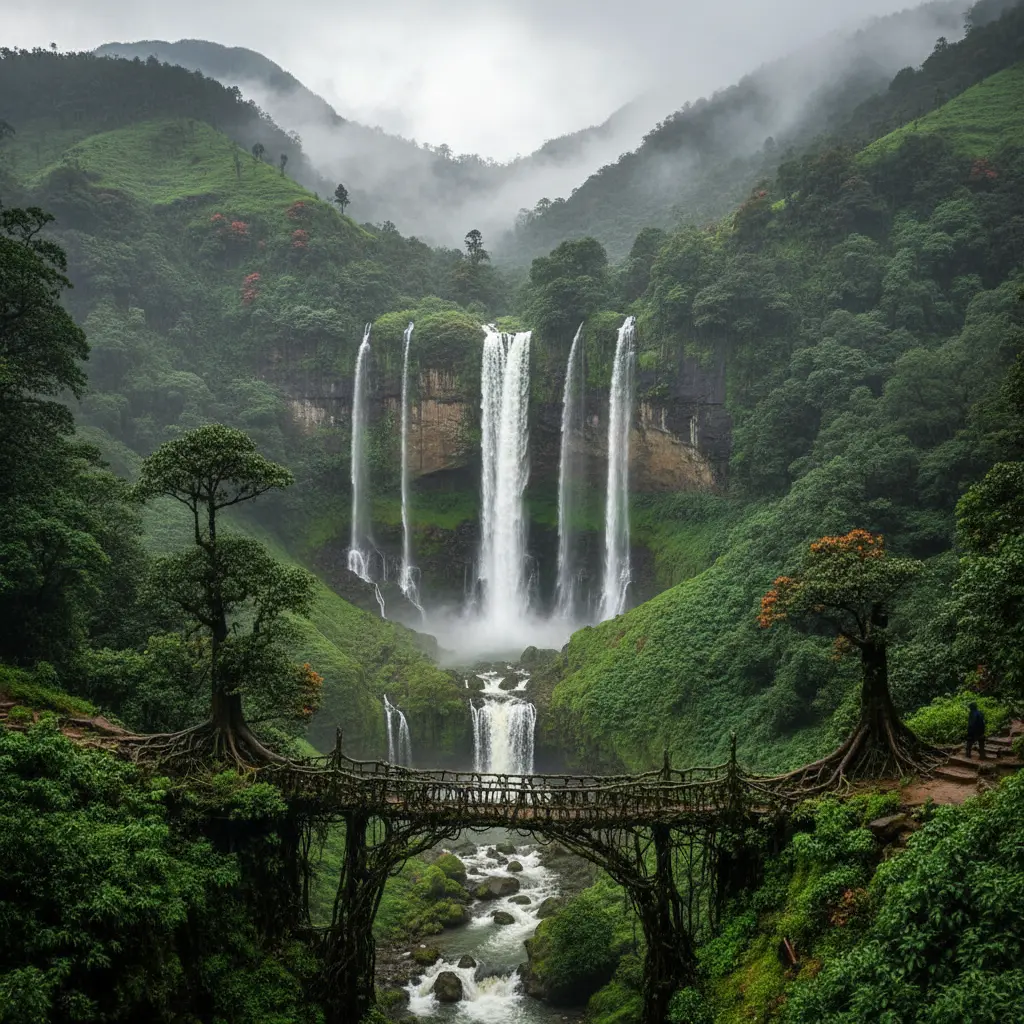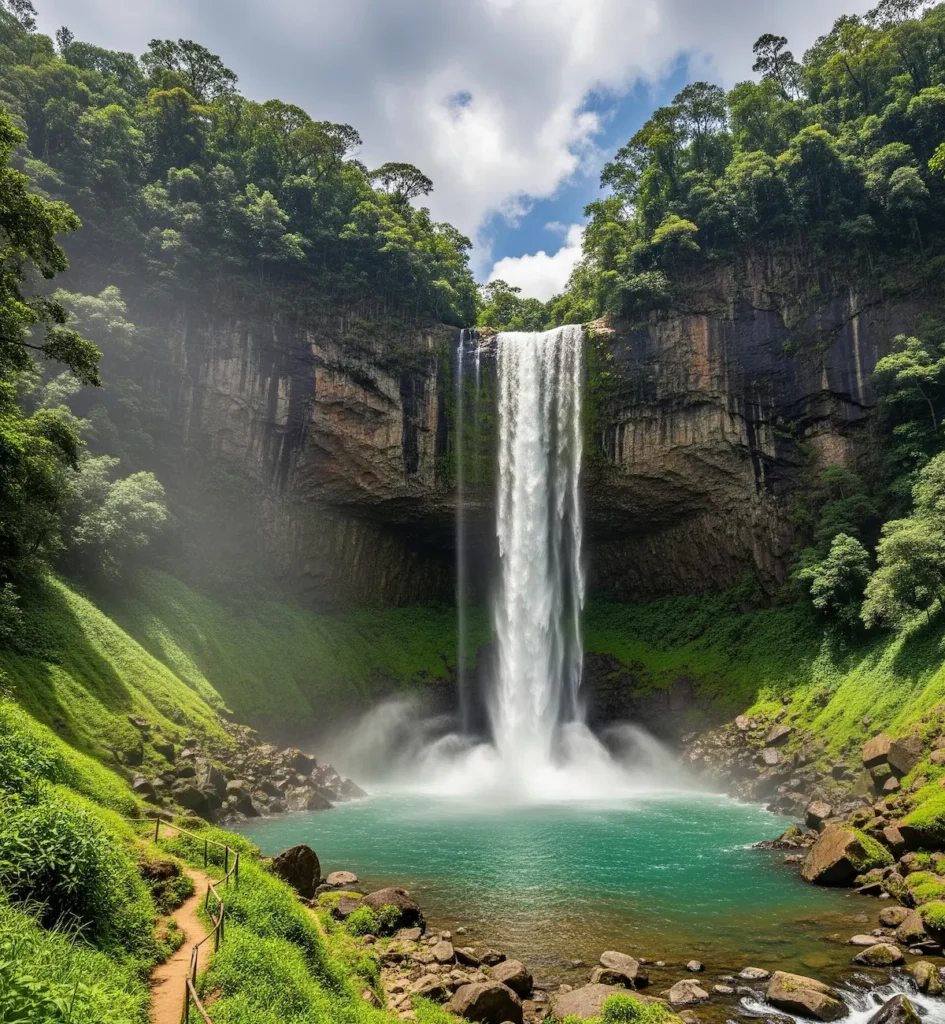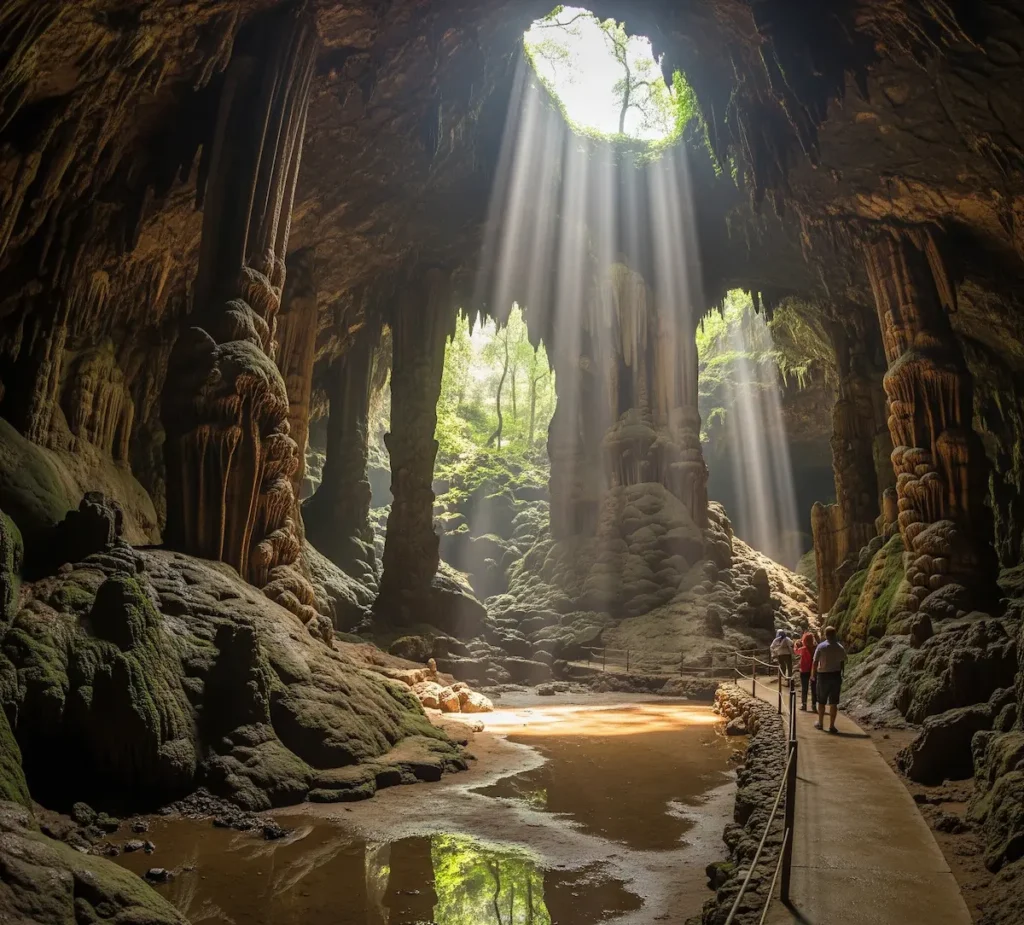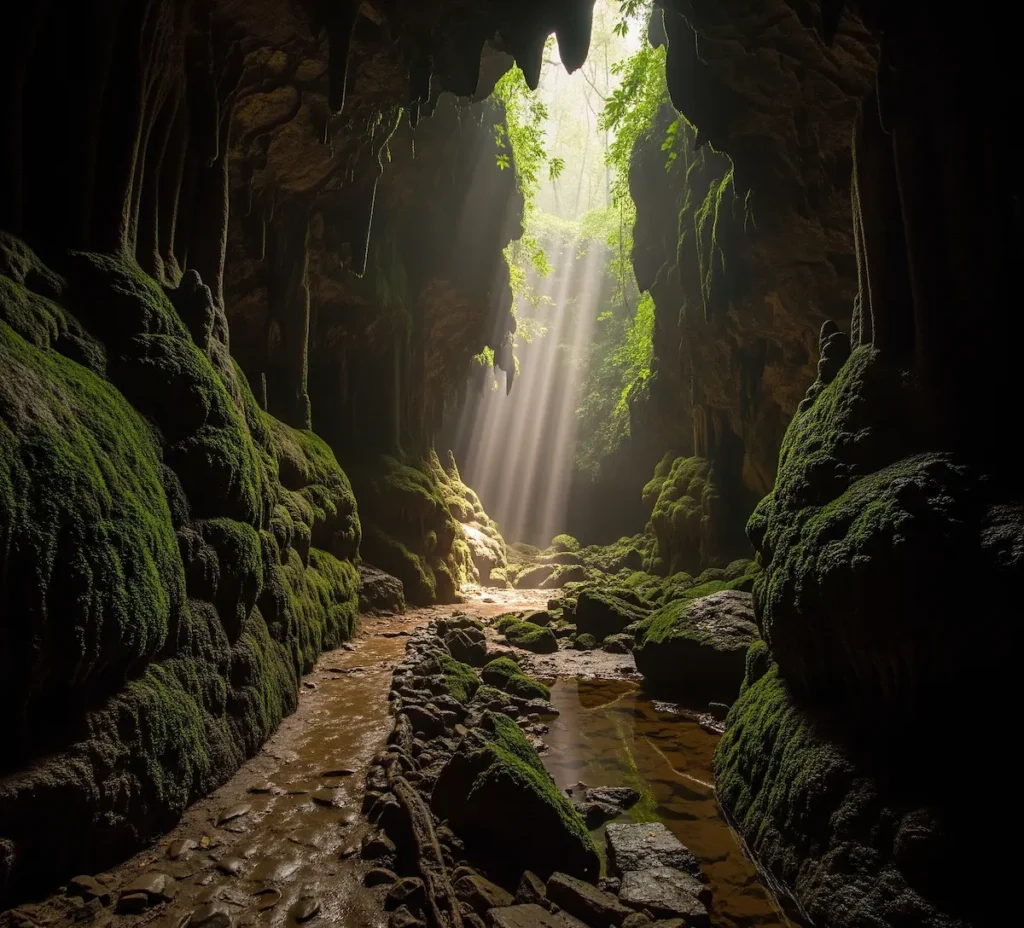Cherrapunji & Shillong: Where Rain Becomes Magic

Cherrapunji (known locally as Sohra) and Shillong sit amidst the misty hills and are iconic for holding global records for rainfall. Just 55 km apart, a 2–3 hour scenic drive from each other and from Guwahati Airport, this lush paradise transforms into a breathtaking spectacle during the monsoon. Twin it with the cultural charm of Shillong, and you have one of India’s most extraordinary rain-soaked escapes.
1. Where It Is & When To Go:
Location:
- East Khasi Hills, Meghalaya; Cherrapunji at 1,430 m above sea level. Shillong is the hill capital, just a 2–3 hr scenic drive away.
Best Time:
- Monsoon (June–Sept) heaviest rains (1400 mm+ monthly rainfall), dynamic waterfalls filling up, emerald forests.
- Also ideal for photographers and adventure-seekers chasing dramatic landscapes.
- Alternative windows: Late monsoon (Oct–Nov) offers slightly calmer weather with still-lush landscapes.
2. How to Reach & Getting Around
By Air:
- Fly to Guwahati (~165 km).
- Shared taxi to Shillong (₹300–700 per person), onward to Cherrapunji (₹300–400).
By Train:
- Nearest railhead is Guwahati; same onward travel as above.
Getting Around:
- Day tours via shared or private cabs (₹2,000–3,000/day). Shared options are cost-effective (~₹600–800/head).
- Local buses are cheaper but less flexible.
Car Rental:
- Approx. ₹2,000–2,500/day (exclusive) offers flexibility.
3. Budget-Friendly Accommodation
Shillong:
- Budget: homestays in Laitumkhrah (~₹1,000–2,500/night).
- Mid-range: Ri‑Kyinjai Resort near Umiam Lake (~₹3,000–6,000).
Cherrapunji:
- Budget: Guesthouses/homestays (~₹1,000–1,500).
- Mid-Range: Jiva, Cherrapunji Holiday, Polo Orchid (~₹3,000–5,000).
- Exclusive View: Camping near waterfalls (~₹1,000–1,500 incl. bonfire).

4. Top 7 Must‑See Attractions
| Place | Location | Entry Fee (INR) | Highlights |
|---|---|---|---|
| Nohkalikai Falls | Near Sohra town | ₹20 | India’s tallest plunge waterfall (340 m); best seen during monsoon |
| Seven Sisters Falls | Mawsmai, Cherrapunji | Free | 7 cascading waterfalls side by side; stunning views post heavy rain |
| Double-Decker Root Bridge | Nongriat village | ₹50 (bridge area) + Guide ₹500 | Living root bridge made from ficus tree roots; 3,000+ stairs to trek down |
| Rainbow Falls | Beyond Nongriat | Free + Guide | Boating on a crystal-clear river; pebble beds visible through the water |
| Wei Sawdong Falls | Near Mawsmai | ₹30–₹50 (varies) | The azure blue waterfall was reached after an extra trek from the Double-Decker bridge |
| Dainthlen Falls | Sohra–Pynursla road | Free | Legend of a slain serpent; flat surface for walking near the fall |
| Wah Kaba Falls | Sohra road | ₹10–₹20 | Steep 190 m drop, foggy cliffs, short downhill trek |
| Mawsmai Caves | Near Cherrapunji | ₹20 (Indians), ₹50 (foreigners) | Easy walk-in caves with lit limestone formations |
| Arwah Caves | Law Shynna, Cherrapunji | ₹20–₹30 | Larger, darker cave with fossils and formations; guided option available |
| Laitlum Canyon | Shillong outskirts | Free | Vast canyons with rolling mist and hill views; trek to remote villages |
| Dawki (Umngot River) | Indo-Bangla border | ₹700–₹1,000/boat | Boating on a crystal-clear river; pebble beds are visible through the water |
| Mawlynnong Village | Near Dawki | ₹50 (village), ₹30 (bridge) | Asia’s cleanest village, Living Root Bridge, skywalk tower |
Notes:
Entry fees are approximate and may vary seasonally or for foreigners
- Many natural sites are free or have a
minimal cost, but trekking with a local guide is recommended (₹300–₹800).
Some guesthouses or eco-camps include free access to nearby falls or guided walks.

5. Local Food Worth the Go
Khasi Delights:
- Jadoh, Dohneiiong (black sesame pork), Tungrymbai, Pukhlein, Doh Khleh, Kyat, Zan
Best Spots:
- Local dhabas for authentic taste (₹100–200/plate).
- Shillong cafés: Café Shillong, Dejavu, Dylan’s Café (~₹400–900/day).
6. Budget and Costs
Travel:
- Guwahati–Shillong–Cherrapunji shared transport: ₹600–1,200 total.
Accommodation:
- ₹1,000–1,500/night (budget), ₹3,000–5,000 (mid-range).
Food:
- ₹400–1,200/day
Activities (falls/caves/treks):
- ₹20–100 per site + guided treks ₹500.
7. Expert Tips & Warnings
1. What to Pack: Waterproof shoes, sturdy raincoat, quick-dry clothes, waterproof bags.
2. Connectivity: Limited mobile data download maps offline, and carry physical copies.
3. Health & Safety: Watch for slippery trails, acclimatize, trek with local guides.
4. Cash Backup: ATMs are scarce, so carry sufficient cash.
5. Responsible Travel: Avoid litter, respect tribal customs, and stay on designated trails
If you want to know more places where you can experience Dual-Seasons, then check out our exclusive post: 7 thrilling dual-season experiences in India: monsoon mystique & winter warrior adventures for solo travelers & couples
8. Why This Trip Will Move You
- Pure Nature Immersion: Deep rainforest vibes, starlit forest camps, cloud-laced treks.
- Unique Culture: Live Khasi hospitality, learn their rhymes, traditions, and root-bridge engineering.
- Offbeat Charm: Less crowded than Goa or Coorg, it feels like you’ve discovered a secret world.
- Evergreen Renewal: Return rejuvenated waterfalls to soothe, mountain air to invigorate.
Conclusion: A Rain Lover’s Paradise
Cherrapunji and Shillong, two sides of Meghalaya’s riotous beauty, offer a monsoon experience brimming with breathtaking waterfalls, ancient living root bridges, sky-high viewpoints, and soul-satisfying Khasi cuisine. This immersive journey is well-suited for adventurous souls, couples seeking romance in the rain, or solo travelers chasing wild monsoon magic.
Don’t wait for the rains to fade, experience India’s monsoon marvel before it slips away this season!

Quick Guide:
- When: Jun–Sept (peak), Oct–Nov (post-monsoon calm)
- Stay: Homestays, camps near waterfalls, mid-range resorts
- Explore: Waterfalls, caves, root bridges, treks, and local life
- Eat: Khasi homemade meals & Shillong café cuisine
- Budget: ₹1,500–3,500/day overall
- Pack: Rain gear, batteries, offline maps, cash
Let Meghalaya’s rains reveal its magic to you; you’re just a trip away.
Have trek or travel questions? Drop a comment below, and we’ll help you personalize your trip.
FAQs
1. Is Cherrapunji better to visit in summer or monsoon?
Cherrapunji is famous for its monsoon rains (June–September) when waterfalls are at their peak. Summer (March–May) offers clearer skies and easier trekking, but less dramatic waterfalls.
2. How many days are enough for Shillong and Cherrapunji?
A 4–5 day trip is ideal: 2 days in Shillong for the city, lake, and nearby attractions, and 2–3 days in Cherrapunji for waterfalls, caves, and living root bridges.
3. Can I do a one-day trip to Cherrapunji from Shillong?
Yes, Cherrapunji is about 2–3 hours from Shillong by road. Many tourists do it as a day trip, but staying overnight allows more time to explore root bridges and less-visited waterfalls.
4. What are the best waterfalls to visit in Cherrapunji?
Popular waterfalls include Nohkalikai Falls, Seven Sisters Falls, Wei Sawdong Falls, and Dainthlen Falls. Each offers unique views and is especially stunning during the rainy season.
5. How do I reach the Double Decker Living Root Bridge?
The trek to the bridge starts from Tyrna village near Cherrapunji. It takes 3,000+ steps (around 2–3 hours one way), so comfortable footwear and stamina are needed.
6. Is Dawki worth visiting from Shillong?
Yes, Dawki is about 80 km from Shillong and famous for the crystal-clear Umngot River, where boating is a must-do activity. Many tourists combine Dawki with Mawlynnong, Asia’s cleanest village.
7. What food is Shillong and Cherrapunji famous for?
Local Khasi dishes like Jadoh (rice with meat), Tungrymbai (fermented soybean curry), and smoked meats are popular. Shillong also has a vibrant café culture with continental and fusion food.
8. Is it safe to travel to Meghalaya during the monsoon?
Yes, it is safe, but expect heavy rains, slippery paths, and possible delays. Hiring local guides and drivers helps ensure safety during treks and long drives.
9. Which is cheaper for a stay: Shillong or Cherrapunji?
Both places offer budget homestays and mid-range hotels. Shillong generally has more options in all ranges, while Cherrapunji is better for nature stays and homestays near waterfalls.
10. What should I pack for a Shillong and Cherrapunji trip?
Essentials include a raincoat/umbrella, waterproof shoes, quick-dry clothes, a power bank, offline maps, and cash (as ATMs may be limited).